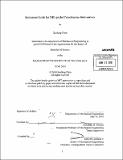Instrument guide for MRI-guided percutaneous interventions
Author(s)
Chen, Xuefeng, S.B. Massachusetts Institute of Technology
DownloadFull printable version (9.431Mb)
Alternative title
Instrument guide for Magnetic Resonance Imaging-guided percutaneous interventions
Other Contributors
Massachusetts Institute of Technology. Dept. of Mechanical Engineering.
Advisor
Alexander H. Slocum.
Terms of use
Metadata
Show full item recordAbstract
As MRI guided interventions are becoming more widely practiced, the goal of this thesis was to design an instrument guidance device for MRI-guided percutaneous interventions in closed bore systems, namely cryoablation procedures where multiple probes need to be placed to treat a tumor. Multiple meetings with researchers and clinicians the Brigham and Women's Hospital were conducted to understand the challenges currently faced by interventionists, to set functional requirements for the design of a system to overcome them, and to help select a clinically viable strategy. The strategy selected involved making a device that had two degrees of angular freedom about a remote center of motion located at the probe entry point on the skin. This device is designed to be incorporated with a custom built MR coil. Structural and finite element analysis was conducted for a number of different mechanism concepts to examine their stiffness and the effect of structural displacements on the end-point probe placement accuracy. The selected concept was a curved arm piece that travels around the pivot point on a circular base, and an additional needle holder that travels along the curved arm. The sliding parts were designed with five points of constraint so that only sliding motion was possible. Thumb screws were used for preload and locking so that the probe guide could be locked along a specific trajectory. The device was prototyped via stereolithography as a proof of concept. It was found that sanding was required to fit the parts together because of overbuild in the stereolithography process. The parts functioned as designed and demonstrated that a probe could be angled about a remote pivot point. However, wear of the plastic parts eventually caused increased play between the plastic parts. Further testing and optimization of the device is planned.
Description
Thesis (S.B.)--Massachusetts Institute of Technology, Dept. of Mechanical Engineering, 2010. Cataloged from PDF version of thesis. Includes bibliographical references (p. 50).
Date issued
2010Department
Massachusetts Institute of Technology. Department of Mechanical EngineeringPublisher
Massachusetts Institute of Technology
Keywords
Mechanical Engineering.